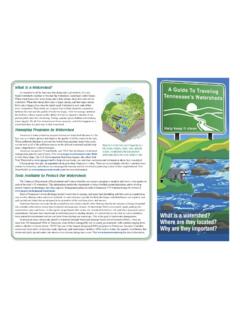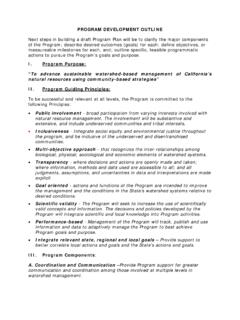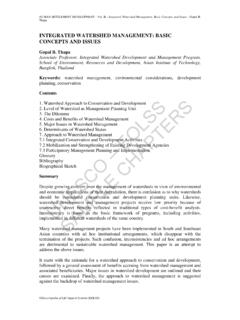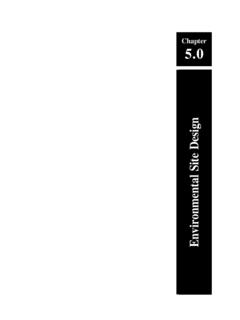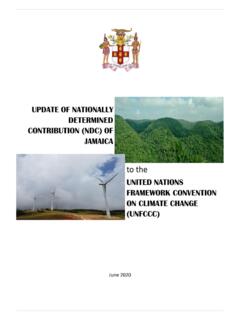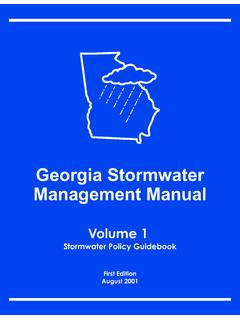Transcription of RULE C: STORMWATER MANAGEMENT - Rice Creek …
1 14 RULE C: STORMWATER MANAGEMENT 1. POLICY. It is the policy of the Board of Managers to manage STORMWATER and snowmelt runoff on a local, regional and watershed basis; to promote natural infiltration of runoff throughout the District to preserve flood storage and enhance water quality; and to address the unique nature of flooding issues within the Flood MANAGEMENT Zone, through the following principles: (a) Maximize water quality and flood control on individual project sites through Better Site Design practices and STORMWATER MANAGEMENT . (b) Minimize land use impacts and improve operational and maintenance efficiency by siting STORMWATER BMPs, when needed, regionally unless local resources would be adversely affected.
2 (c) Treat STORMWATER runoff before discharge to surface waterbodies and wetlands, while considering the historic use of District water features. (d) Ensure that future peak rates of runoff are less than or equal to existing rates. (e) Reduce the existing conditions peak rate of discharge along Lower Rice Creek and the rate of discharge and volume of runoff reaching Long Lake, to preserve the remaining floodplain storage volume within Long Lake and mitigate the historic loss of floodplain storage. (f) Preserve remaining floodplain storage volume within the Rice Creek Watershed to minimize flood potential throughout the District.
3 2. REGULATION. A permit incorporating an approved STORMWATER MANAGEMENT plan is required under this rule for development, consistent with the following: (a) A permit is required for subdivision of an area exceeding one acre. This includes subdivision for single-family residential, multi-unit residential, commercial, industrial, or institutional development. (b) A permit is required for development, other than Public Linear Projects, that creates or reconstructs 10,000 square feet or more of impervious surface. This threshold is cumulative of all impervious surface created or reconstructed through multiple phases or connected actions of a single complete project, as defined by the District, on a single parcel or contiguous parcels of land under common ownership, development or use.
4 (c) For Public Linear Projects, a permit is required when one acre or more of impervious surface will be created or reconstructed through multiple phases or connected actions of a single complete project, as defined by the District. 3. STORMWATER MANAGEMENT plan REQUIRED. A STORMWATER MANAGEMENT plan shall be submitted with the permit application for a project equaling or exceeding the threshold of Section 2. The STORMWATER MANAGEMENT plan shall fully address the design and function of the project proposal and the effects of altering the landscape relative to the direction, rate of discharge, volume of discharge and timing of runoff.
5 4. MODELING REQUIREMENTS FOR STORMWATER MANAGEMENT PLANS. (a) A hydrograph method or computer program based on NRCS Technical Release #20 (TR- 20) and subsequent guidance must be used to analyze STORMWATER runoff for the design or analysis of discharge and water levels within and off the project site. The runoff from 15 pervious and impervious areas within the model shall be modeled separately. (b) In determining Curve Numbers for the post-development condition, the Hydrologic Soil Group (HSG) of areas within construction limits shall be shifted down one classification for HSG C (Curve Number 80) and HSG B (Curve Number 74) and classification for HSG A (Curve Number 49) to account for the impacts of grading on soil structure unless the project specifications incorporate soil amendments in accordance with District Soil Amendment Guidelines.
6 This requirement only applies to that part of a site that has not been disturbed or compacted prior to the proposed project. (c) The analysis of flood levels, storage volumes, and discharge rates for waterbodies and STORMWATER MANAGEMENT basins must include the NOAA Atlas 14 values, as amended, using a nested rainfall distribution ( MSE 3), for the 2 year, 10 year and 100 year return period, 24-hour rainfall events and the 10-day snowmelt event (Curve Number 100), in order to identify the critical duration flood event. The District Engineer may require analysis of additional precipitation durations to determine the critical duration flood event.
7 Analysis of the 10-day snowmelt event is not required for STORMWATER MANAGEMENT detention basins with a defined outlet elevation at or below the 100 year return period, 24-hour rainfall event elevation. 5. STORMWATER MANAGEMENT plan FRAMEWORK. (a) When an existing regional BMP is proposed to manage STORMWATER runoff, the proposed total impervious surface area must be equal to or less than the impervious surface allocated within the original approved STORMWATER plan for that site. If an impervious surface area was not specified within the original approved STORMWATER plan for the site, the applicant shall show that the BMP was designed and constructed to manage the STORMWATER runoff from the project site, the applicant has permission to utilize any remaining capacity in the BMP, the BMP is subject to maintenance obligations enforceable by the District, and it is being maintained to its original design.
8 (b) STORMWATER MANAGEMENT plans, with the exception of those for single family residential developments, must specify the proposed impervious surface area draining to each BMP for each land parcel (c) A combination of STORMWATER BMPs may be used to meet the requirements of section(s) 6, 7, and 8. (d) A local surface water MANAGEMENT plan or ordinance of the local land use authority may contain standards or requirements more restrictive than these rules. The STORMWATER MANAGEMENT plan must conform to the local surface water MANAGEMENT plan or ordinance of the local land use authority. (e) The proposed project must not adversely affect off-site water levels or resources supported by local recharge, or increase the potential for off -site flooding, during or after construction.
9 (f) A landlocked basin may be provided an outlet only if it: (1) Conforms with District Rule F, as applicable. (2) Provides sufficient dead storage volume to retain the runoff resulting from back-to- back 100-year, 24-hour rainfall events. 16 (3)Does not create adverse downstream flooding or water quality conditions as aresult of the change in the rate, volume or timing of runoff or a change in drainagepatterns.(g)A municipality or public road authority may prepare a comprehensive stormwatermanagement plan setting forth an alternative means of meeting the standards of sections 6and 7 within a defined subwatershed. Once approved by the District and subject to anystated conditions, the plan will apply in place of those QUALITY TREATMENT.
10 (a)Development creating or reconstructing impervious surface shall apply Better Site Design (BSD) techniques as outlined in the MPCA Minnesota STORMWATER Manual as amended ( ). A BSD guidance document and checklist is available on the District s website.(b)Sediment shall be managed on-site to the maximum extent practicable before runoff resulting from new or reconstructed impervious surface enters a waterbody or flows off-site.(c)WATER QUALITY TREATMENT STANDARD.(1)The required water quality treatment volume standard for all projects, except Public Linear Projects, is determined as follows: Required Water Quality Treatment Volume (ft3) Area of New or Reconstructed = Impervious Surface (ft2) x (in) TP Removal Factor from Table C1 12 (in/ft) (2)The required water quality treatment volume standard for Public Linear Projectsis determined as follows.

